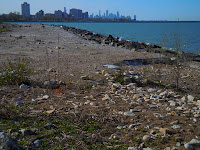After thoroughly exploring the beach, it came time to move south. By now the sun, which had been gradually scattering the mist, had fully illuminated the now clear sky. Heading into the woods it wasn’t long before I came up to my first wetland; a rather large pond. While I surveyed the site I didn’t notice the beaver quietly swimming along.

 It just so happened that I was standing at the edge of a bottle neck that connected two ponds. The beaver’s lodge was in the next pond, so naturally he noticed me at the pass and slapped the water in alarm completely surprizing me. I moved away to explore further and let the beaver get home. It is probably worth noting that I probably would be seeing literally tones of birds if I wasn’t spending so much time looking down instead of up. That said I think I’ll try to balance the up and down a little more in my next trip. Anyway, in this area I came across both a Green Heron (Butorides virescens) and great blue heron (Ardea herodius). I also found throughout the area a plethora of the critical and beautiful purple Wild Lupine (Lupinus perennis) another first for me, an at the time of this post still unknown yellow plant (though I suspect it’s a type of hyssop), and a few plants of ruby/yellow Wild Columbine (Aquilegia canadensis). I say critical in reference to Lupine, not because it is necessarily in trouble, but because it is the sole food source for the larva of the endangered Karner Blue Butterfly (Lycaeides melissa).
It just so happened that I was standing at the edge of a bottle neck that connected two ponds. The beaver’s lodge was in the next pond, so naturally he noticed me at the pass and slapped the water in alarm completely surprizing me. I moved away to explore further and let the beaver get home. It is probably worth noting that I probably would be seeing literally tones of birds if I wasn’t spending so much time looking down instead of up. That said I think I’ll try to balance the up and down a little more in my next trip. Anyway, in this area I came across both a Green Heron (Butorides virescens) and great blue heron (Ardea herodius). I also found throughout the area a plethora of the critical and beautiful purple Wild Lupine (Lupinus perennis) another first for me, an at the time of this post still unknown yellow plant (though I suspect it’s a type of hyssop), and a few plants of ruby/yellow Wild Columbine (Aquilegia canadensis). I say critical in reference to Lupine, not because it is necessarily in trouble, but because it is the sole food source for the larva of the endangered Karner Blue Butterfly (Lycaeides melissa).Traveling along the ridges, I found it to be quite an adventure trying to find my way forward in the maze of wetlands that at any given point could be connected and subsequently bar a path forcing me to retrace steps or turn down a new ridge. The wetlands were also nestled within already established dunes as every slope into a wetland was steep. Some of the ways forward were also thick with shrubs and young trees. Why there were masses of saplings that were mostly the same age is beyond me. Soon enough I entered Miller woods and ended the day on a board walk above a marsh where I spotted yet another beaver.
This was an awesome adventure; the first really proper spring trip with boundless flowers, birds, colorful budding trees, and beavers. It was a day of new sightings for birds, flowers, and habitats. In addition, rarely have I witnessed natural areas that show so little sign of disturbance or human presence; pristine. The only way I know of to get the splendor that I witnessed across is what I’ve written in this blog. I was so captured while traveling that I hadn’t considered at all parasites. Luckily I seem to have come away with only one mosquito bite. I can’t encourage you to go out enough. Either ideal or foul the weather, it is so worth it to get out there. The trees are flooding with leaves. Spring is quickly going to give way to summer!
See you all in the field!
Edward Warden































